Themed collection Next-Generation Organic/Hybrid Photovoltaics

New developments in non-fullerene small molecule acceptors for polymer solar cells
This review describes developments of non-fullerene small molecular acceptors in solar cells since 2015, including rylene imide, indacenodithiophene and diketopyrrolopyrrole.
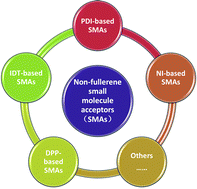
Mater. Chem. Front., 2017,1, 1291-1303
https://doi.org/10.1039/C6QM00247A
Side-chain engineering of perylenediimide-vinylene polymer acceptors for high-performance all-polymer solar cells
The performance of a PDI-vinylene polymer acceptor in an all-PSC is optimized by side-chain engineering. The best average PCE of 7.40% is obtained with a medium side-chain length.

Mater. Chem. Front., 2017,1, 1362-1368
https://doi.org/10.1039/C6QM00355A
Significantly improving the efficiency of polymer solar cells through incorporating noncovalent conformational locks
The power conversion efficiency of polymer solar cells was significantly enhanced through introducing conformational locks into the backbone of polymers.
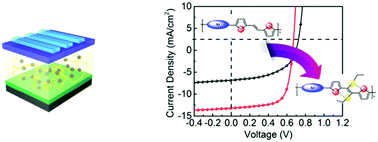
Mater. Chem. Front., 2017,1, 1317-1323
https://doi.org/10.1039/C6QM00296J
Synthesis and photovoltaic properties of three different types of terpolymers
A series of terpolymers (Random, Regular and Block) based on dithienylphenylene, difluorobenzothiadiazole and dicyanobenzothiadiazole moieties were synthesized, and their optical, electrochemical, morphological, electrical and photovoltaic properties were studied.
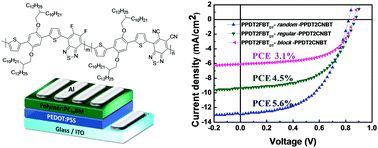
Mater. Chem. Front., 2017,1, 1147-1155
https://doi.org/10.1039/C6QM00267F
High open-circuit voltage ternary organic solar cells based on ICBA as acceptor and absorption-complementary donors
A high open-circuit voltage of 0.98 V in ternary organic solar cells is achieved by using ICBA as an acceptor and two absorption-complementary donors.
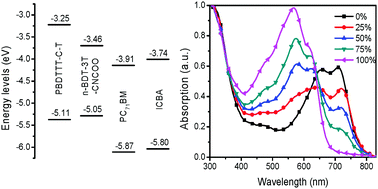
Mater. Chem. Front., 2017,1, 1223-1228
https://doi.org/10.1039/C6QM00308G
A perylene diimide based polymer: a dual function interfacial material for efficient perovskite solar cells
An n-type semiconducting copolymer of perylene diimide and dithienothiophene (PPDIDTT) is used as a dual function interfacial layer to modify the surface of perovskite films in inverted perovskite solar cells, which exhibit higher efficiency and better stability.

Mater. Chem. Front., 2017,1, 1079-1086
https://doi.org/10.1039/C6QM00309E
Controlled self-aggregation of perylene bisimide and its application in thick photoconductive interlayers for high performance polymer solar cells
Asymmetric perylene bisimide enables a thick photoconductive cathode interlayer (100 nm), even the doping concentration is varied from 0.5 wt% to 5 wt%.
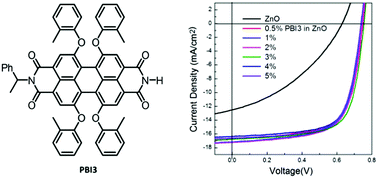
Mater. Chem. Front., 2017,1, 1087-1092
https://doi.org/10.1039/C6QM00286B
Novel donor–acceptor type conjugated polymers based on quinoxalino[6,5-f]quinoxaline for photovoltaic applications
Three novel conjugated polymers based on 2,3,8,9-tetrakis(3-(alkoxy)phenyl)-6,12-di(thiophen-2-yl)-2,3,8,9-tetrahydroquinoxalino[6,5-f]quinoxaline (DTNQx) were designed and synthesized, and were applied in photovoltaic cells.
![Graphical abstract: Novel donor–acceptor type conjugated polymers based on quinoxalino[6,5-f]quinoxaline for photovoltaic applications](/en/Image/Get?imageInfo.ImageType=GA&imageInfo.ImageIdentifier.ManuscriptID=C6QM00130K&imageInfo.ImageIdentifier.Year=2017)
Mater. Chem. Front., 2017,1, 499-506
https://doi.org/10.1039/C6QM00130K
Design of charge transporting grids for efficient ITO-free flexible up-scaled organic photovoltaics
Grids were integrated onto a top-illumination device with ultra-thin Ag as the TE: grid B further improved the device efficiency by ∼7% compared with grid A due to the shadow loss reduction.
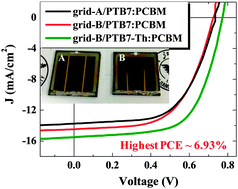
Mater. Chem. Front., 2017,1, 304-309
https://doi.org/10.1039/C6QM00043F
Low-temperature aqueous solution processed ZnO as an electron transporting layer for efficient perovskite solar cells
Low-temperature aqueous solution processed ZnO ETLs for PSCs by spin coating the aqueous solutions of [Zn(NH3)x](OH)2 were reported.
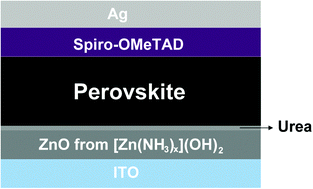
Mater. Chem. Front., 2017,1, 802-806
https://doi.org/10.1039/C6QM00248J
About this collection
Materials Chemistry Frontiers is delighted to publish the following collection of articles on “Next-Generation Organic/Hybrid Photovoltaics”, guest edited by Tobin Marks
(Northwestern University) and Henry Yan (Hong Kong University of Science and Technology).
This themed collection focuses on the science and fabrication techniques of materials and devices that are paving the road towards high-efficient solar energy harvesting. Key topics include but are not limited to:
- Organic photovoltaics
- Perovskite solar sells
- Non-fullerene organic photovoltaics
- Charge transport layers for perovskite solar sells
- Interface engineering for organic/hybrid photovoltaics